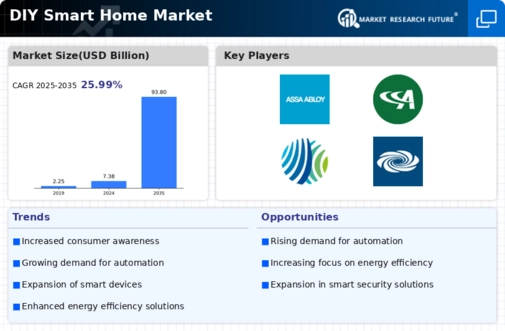Market Trends
Key Emerging Trends in the DIY Smart Home Market
The DIY smart home market is characterized by quickly changing customer tastes and technical advancements, which are driving the industry's trends. The growing popularity of smart gadgets that can be operated by speech is one such development. Voice assistants, like Google Assistant and Alexa from Amazon, are becoming essential parts of do-it-yourself smart home installations because they allow users to operate a variety of devices with simple voice requests. This pattern highlights the increasing need for hands-free, natural interactions, which improves the usability and accessibility of smart homes. The growth of do-it-yourself smart home security systems is another noteworthy development. Customers are increasingly resorting to DIY security systems that provide simple installation and monitoring capabilities as worries about home safety mount. Users may remotely monitor their houses by using motion sensors, doorbell cameras, and smart cameras that are integrated with mobile apps. This trend reflects customers' need for peace of mind and is in line with the growing emphasis on home automation for safety and security. The DIY smart home industry is being shaped by two major key trends: integration and interoperability. Customers want their smart home to be more coherent and united. Thus, they want seamless communication between various smart gadgets. In response, producers are creating goods that follow industry-wide communication standards, increasing interoperability and decreasing compatibility problems. The rising desire for a comprehensive smart home ecosystem—where gadgets cooperate to improve efficiency and convenience—is being met by the trend toward integration. In the DIY smart home sector, sustainability and energy efficiency have also grown in importance. Energy-efficient lights and thermostats are examples of smart gadgets that are becoming more and more popular. These devices are made to maximize energy usage. Customers are becoming more conscious of the impact they have on the environment, and the addition of eco-friendly smart home technologies fits in with the larger sustainable living movement. Manufacturers are including energy-saving features in their goods to appeal to consumers who are concerned about the environment and want to lessen their influence on it. DIY home automation kits and ecosystems are becoming increasingly popular in the DIY smart home industry. These all-inclusive packages offer packaged solutions that incorporate many devices collaborating smoothly, making the process of creating a smart home easier. These kits, which generally contain smart speakers, sensors, and hubs and offer a unified starting point for building a connected home, appeal to do-it-yourselfers and those who are new to smart homes. This trend is a reflection of how the industry has responded to the demand for affordable, approachable, do-it-yourself solutions that a wide spectrum of customers can use.







Leave a Comment